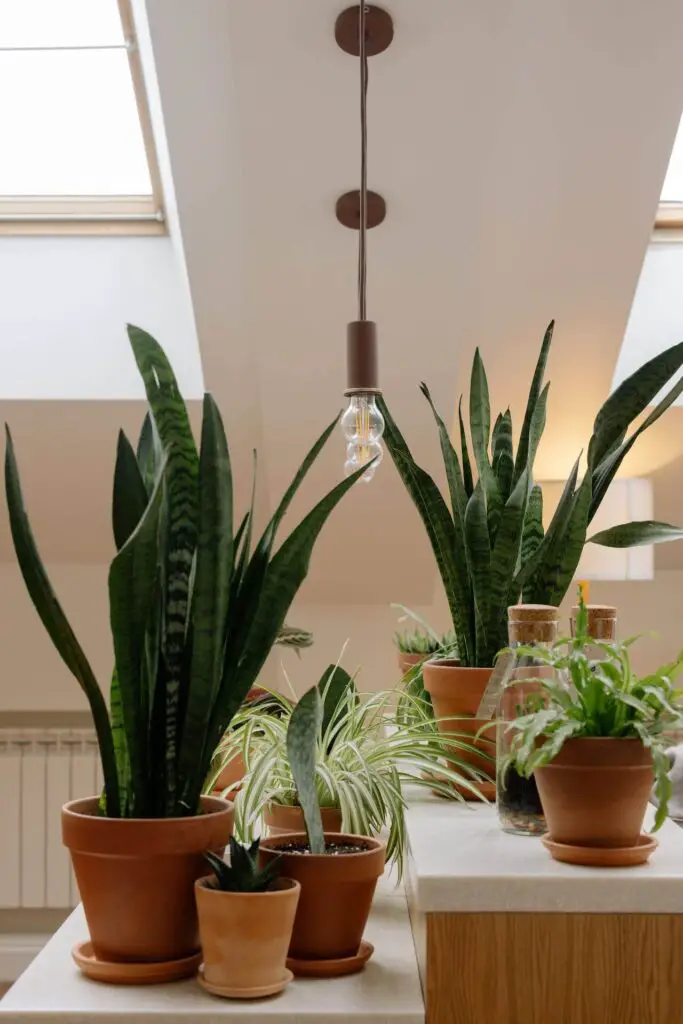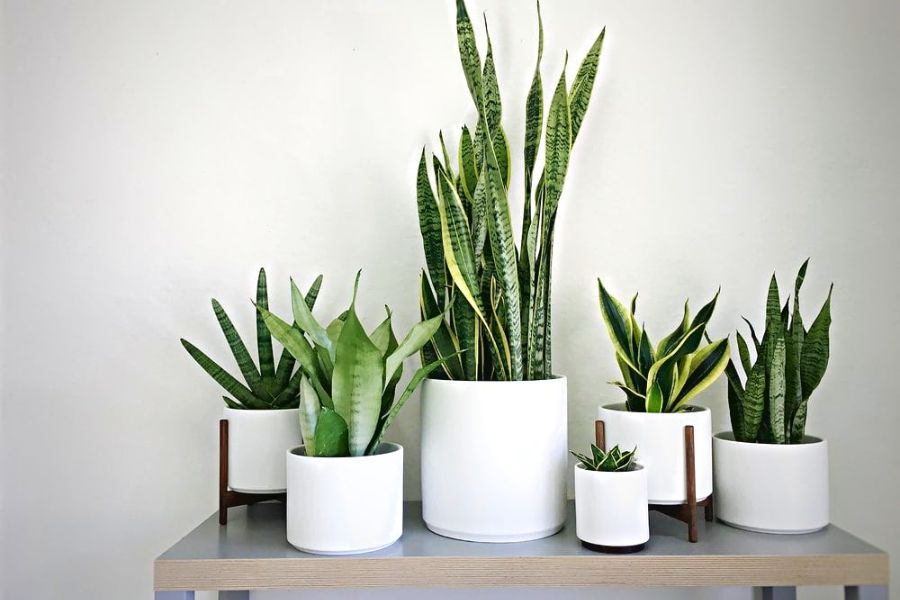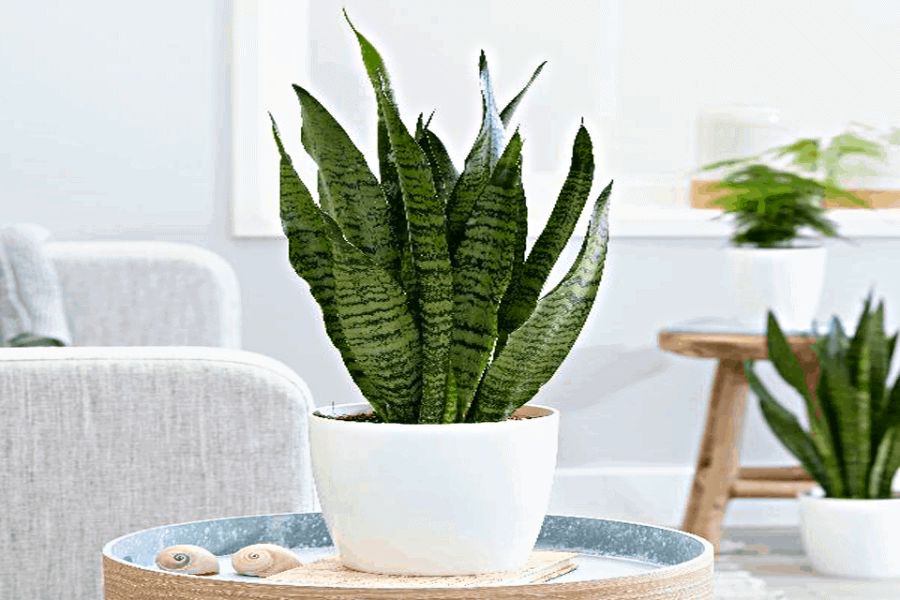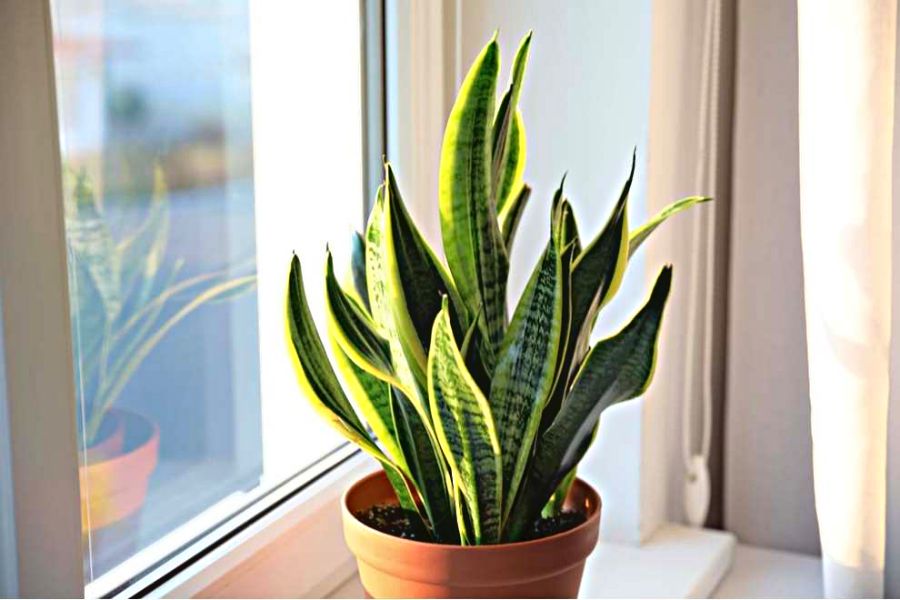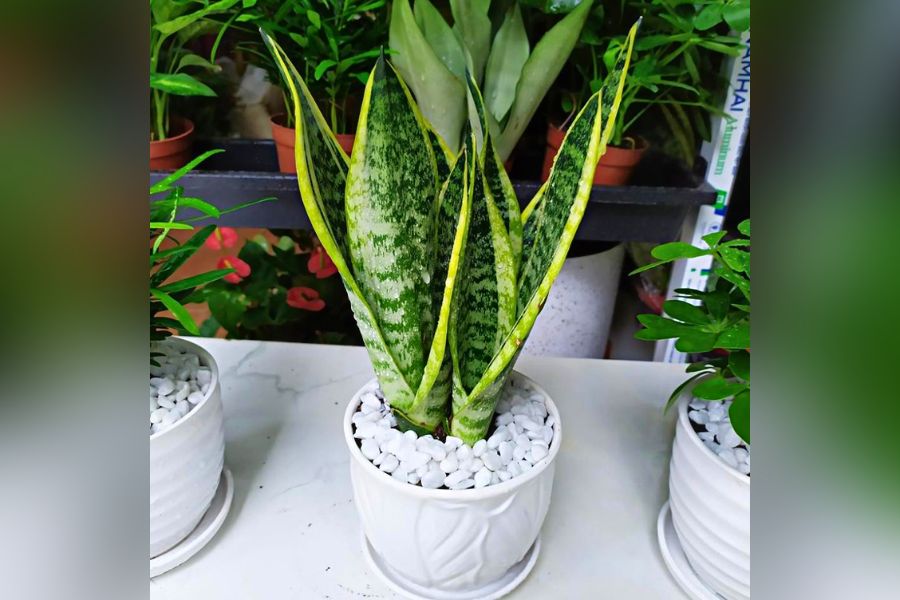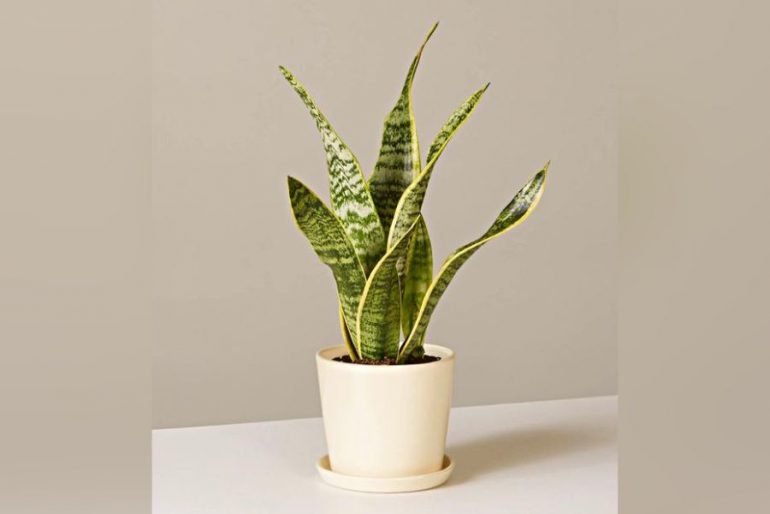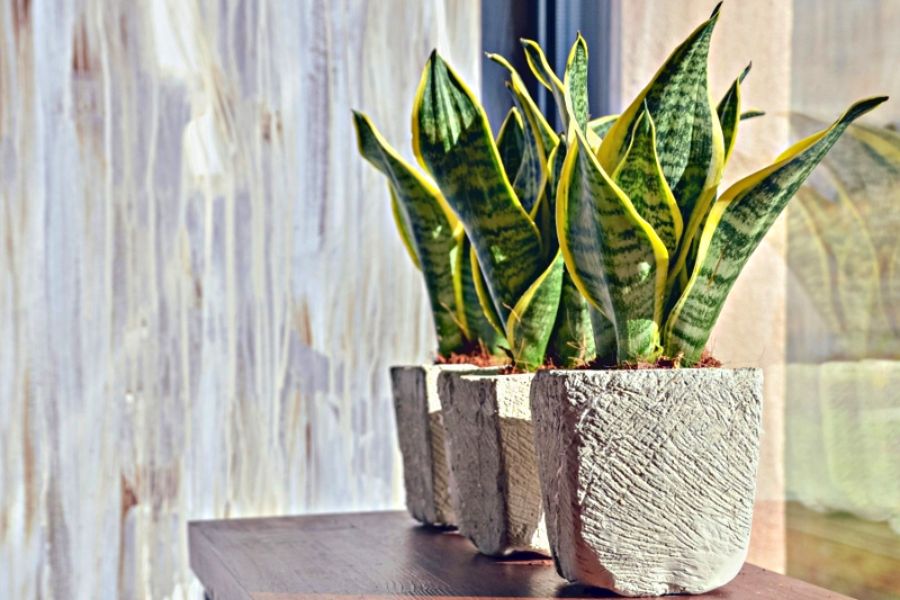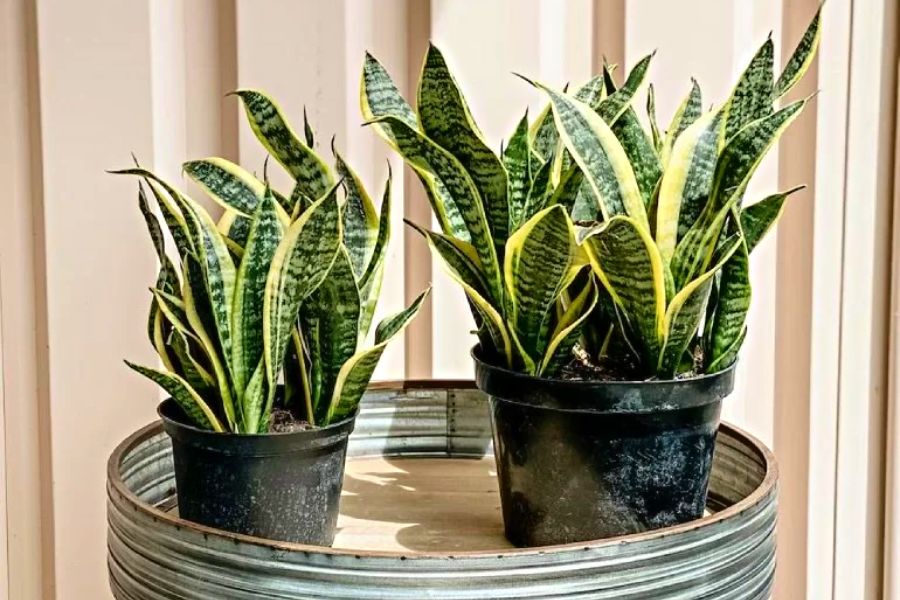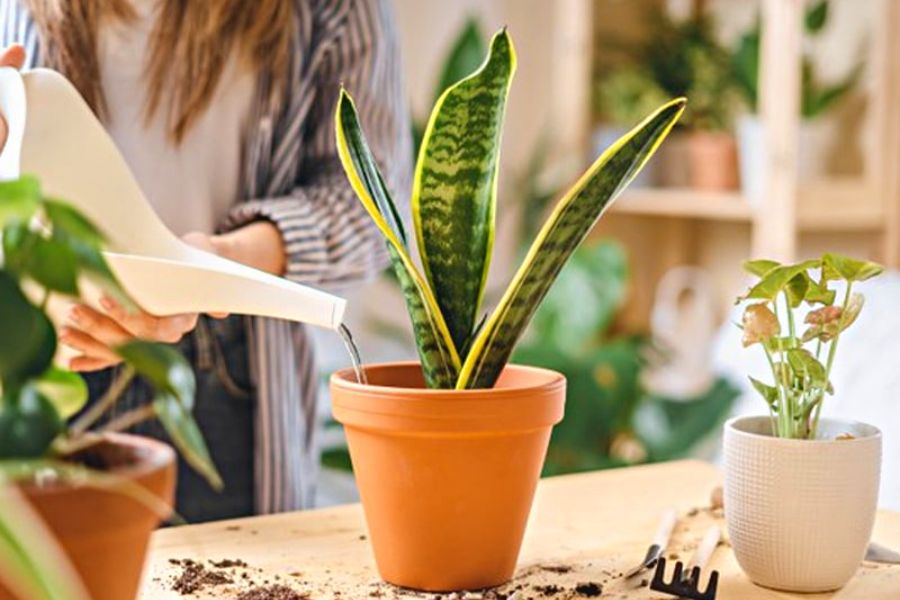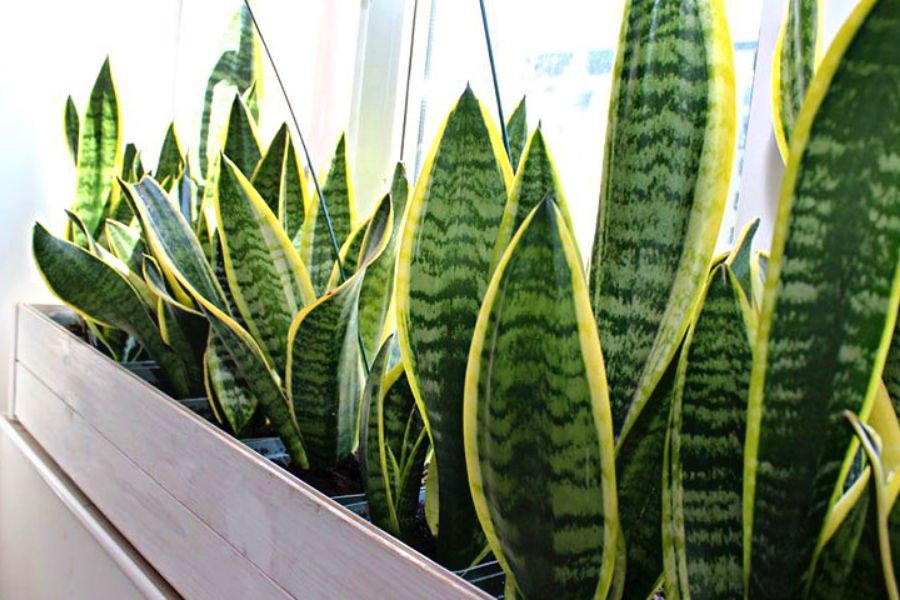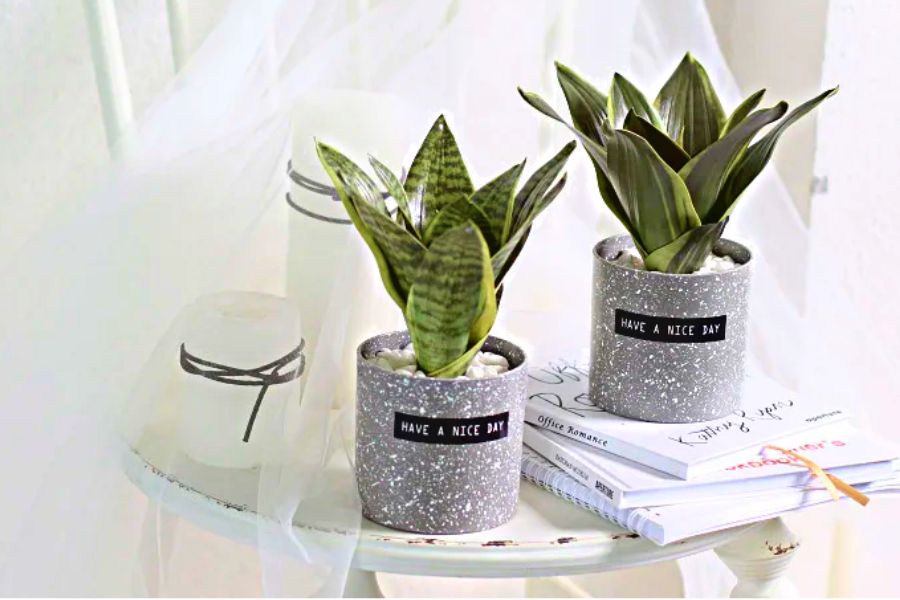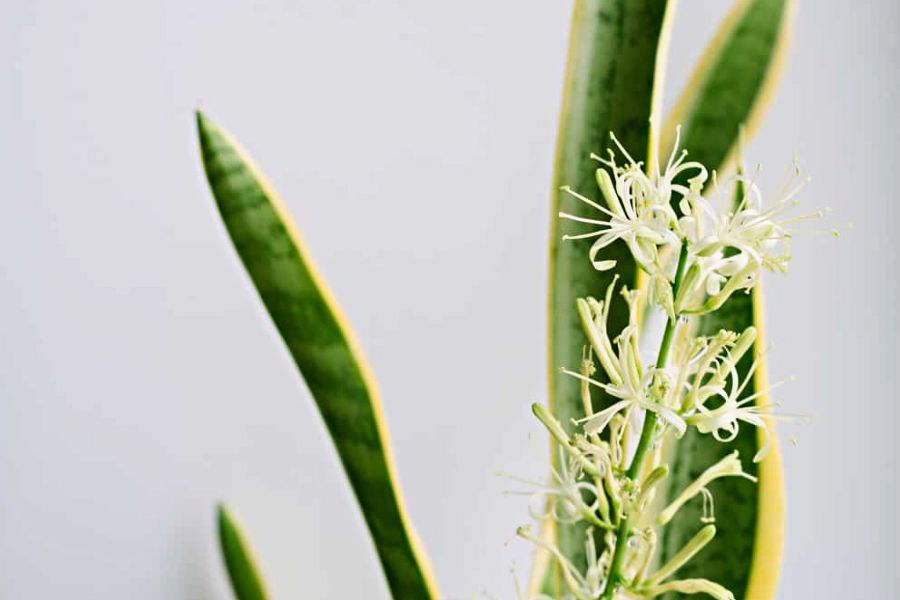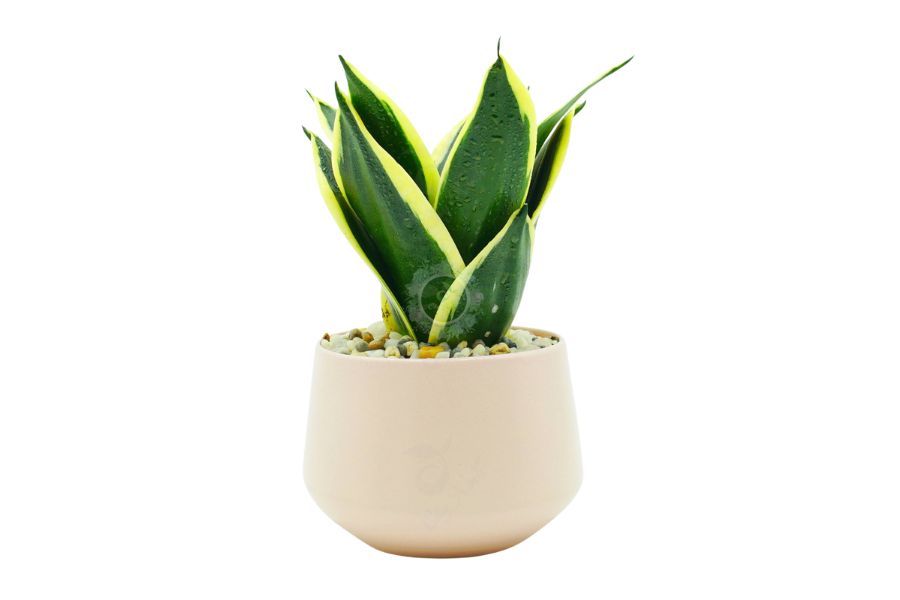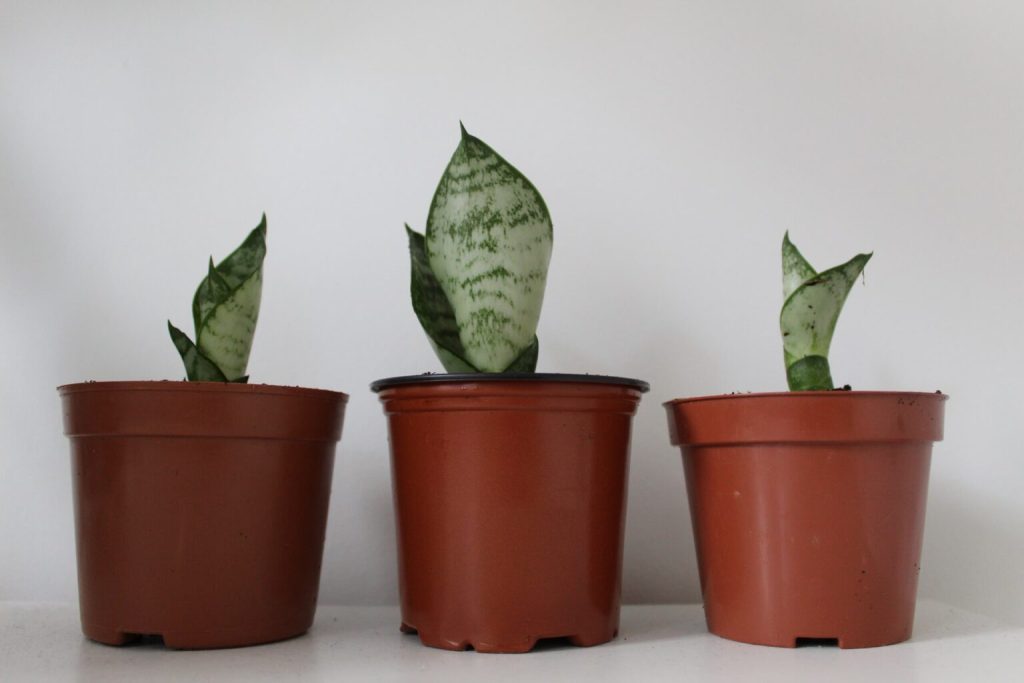If you are interested in growing an ornamental plant to decorate your desk or living room, the snake plant will be a suggestion not to be missed. Let’s learn how to care for and grow snake plants to keep them green through the article below!
Contents
I. Introduction to snake plant
Characteristics of snake plant
The snake plant is a herbaceous plant with long, thick and hard leaves, often growing upright. The scientific name of the snake plant is Sansevieria and it belongs to the Asparagaceae family. The snake plant is native to Africa and is widely grown worldwide as an interior and landscape ornamental plant. In addition, snake plant is also used in the medical and industrial fields. With its ability to withstand drought, heat and poor soil nutrients, the snake plant is considered one of the easiest plants to grow and care for.
The reason the tree is named snake tongue
The snake plant is so named because the shape of its leaves resembles the image of a snake’s tongue. With long, thin, narrow and often upright characteristics, the leaves of the snake plant are dark green or light gray and have white veins that create the characteristic image of this plant. Since then, the name “tiger tongue” has been used to describe the shape of the leaves, making it easier to recognize and name the plant.
II. Types of snake plants are popular today
Currently, there are many types of snake plants grown and commonly used in interior decoration and indoor landscaping . Below is a description of some popular snake plants today:
1. Green snake plant
The green snake plant is a plant native to Africa, with green leaves with white or yellow streaks on the leaf surface. The leaves are thick and large, about 5-6 cm wide and 30-40 cm long. The green snake plant is easy to grow and popular indoors because it can adapt to dry, low-light environments and does not require much care. In addition, the green snake plant also has the effect of filtering the air and helping to increase indoor humidity.
2. Thai snake plant
The Thai snake plant is a plant of the Asparagus family, originating from Africa. The tree has an upright stem, with leaves growing from the base, thick and hard leaves that are 15 to 45 cm long and about 2 to 6 cm wide. The leaves are light green with white or yellow edges. The plant has the ability to adapt to many different soil types and climates, suitable for growing indoors, outdoors or in hotels, offices, and restaurants. The snake plant is loved for its ability to create fresh air and help reduce indoor pollution.
3. Dwarf snake plant
Dwarf snake plant, also known as round snake plant or mini snake plant, is a small tree with a height of 15-30 cm. The leaves of the dwarf snake plant are dark green, especially the trunk is also the characteristic green color of this plant. Dwarf snake plants are very suitable for growing in small pots or decorating desks, bookshelves, windows… In addition, dwarf snake plants also have the effect of filtering the air and helping reduce stress, bringing a fresh and green space. comfortable for the user. Dwarf snake plants are easy to grow and do not require much care, adapting well to dry environments and low light.
4. Golden snake plant
The yellow snake plant is an interior decorative plant with a yellow trunk and green leaves typical of this plant with bright yellow stripes in the middle of the leaves. The yellow snake plant is grown in small pots, very suitable for decorating the living room, office, bedroom or other spaces in the house. In addition to its decorative effect, the yellow snake plant also has the ability to filter the air, helping to reduce pollution in living spaces. The yellow snake plant is also very easy to grow and care for, adapting well to dry environments and low light.
Health effects
Snake plant is said to have many effects on human health. According to some scientific studies, the snake plant has the ability to clean the air by absorbing toxic substances such as benzene, formaldehyde, trichlorethylene and xylene. In addition, the plant also has the ability to reduce headaches, fatigue, reduce stress, improve sleep and increase oxygen levels in the room.
Snake plant is also effective in treating sinusitis and asthma. Many people believe that inhaling the gas of the snake plant can help relieve the unpleasant symptoms of sinusitis and reduce bronchial spasms in asthma patients.
However, it should be noted that the effects of snake plant on human health are still being researched and there is not enough authentic scientific evidence.
Economic effects
As an ornamental plant: The snake plant has upright leaf stems, is durable and quite beautiful, so it is often grown as an ornamental plant in gardens, homes, offices, hotels, restaurants and other locations.
As raw material for paper production: Snake plant leaves contain a lot of fiber, so they are used to produce paper.
As a raw material for fiber production: Fiber from snake plant leaves can be used to produce products such as cables, carpets, non-woven fabrics and other products.
Generates oxygen: Snake plant is one of the few plants that can convert carbon dioxide in the air into oxygen, helping to increase the amount of oxygen in the surrounding environment and improve air quality.
Medicine: According to traditional medicine, snake root has the effect of clearing heat, detoxifying, disinfecting and treating a number of diseases such as fever, sore throat, rhinitis, pneumonia, abdominal pain, diarrhea and other diseases. Other problems. However, before using snake plant as a medicine, you should carefully learn about its effects and appropriate dosage.
Effects of snake plant in feng shui
The snake plant is also considered one of the important feng shui plants in attracting wealth and bringing luck to the homeowner. Below are some effects of the snake plant in feng shui:
- Absorb toxic gases and bring freshness: According to feng shui concepts, the snake plant has the ability to absorb toxic gases and bring fresh air to the room. Therefore, snake plants are often placed in living spaces such as living rooms, bedrooms or offices.
- Create vitality and fortune: Snake plant is considered a plant with the ability to create vitality and attract fortune. Therefore, it is often placed in important locations in the house such as the fortune corner, money receiving area or main door.
- Helps neutralize evil spirits: According to feng shui concepts, the snake plant has the ability to neutralize evil spirits and bring balance to the living space. Therefore, the snake plant is often placed in locations with killing intent such as in front of the house, bedroom, living room or office.
- Enhances energy for users: Snake plant also has the ability to increase energy for users and bring peace and calmness, helping to reduce stress and tension in life.
- In terms of what destiny the snake plant is compatible with, the snake plant is considered compatible with the destiny of Wood (Monkey, Rooster), Water (Rat, Ox, Mao, Tiger, Dog, Pig), Fire (Snake, Horse), Metal (Snake, Rooster). However, for those who do not believe too much in feng shui, planting snake plants may not require concern about the plant’s compatibility.
- According to feng shui concepts, the snake plant is not a type of plant that is not suitable for any age. However, to increase good personality in feng shui, people often recommend choosing a snake plant that is suitable for the homeowner’s age. For example, if the homeowner was born in the year of Tan Suu (1985, 2021), he should choose a snake plant with an even number of leaves such as 2, 4, 6, 8,… to bring luck and fortune.
However, to achieve the feng shui effect of the snake plant, you need to pay attention to the location of the plant and how to care for it to ensure it grows well and brings the best effects.
IV. Experience on how to plant and care for snake plant
Planting and caring for snake plants is not too difficult, but you need to know some of the following experiences to have lush and beautiful snake plants:
1. How to choose the right snake plant variety:
The snake plant has many different varieties, each with its own characteristics. Therefore, when you want to grow snake plants, you should learn carefully about these plant varieties to choose the right variety for your intended use.
2. Effective methods of planting and caring for snake plant:
Soil: Snake plant should be chosen as suitable, good soil, with good water conductivity, helping the plant grow well. Soil mixed with sand or coconut fiber will be the best choice.
Light: Snake plant likes strong light, it is best to place the plant in locations with lots of natural light but avoid direct sunlight.
Water: Snake plants are quite healthy plants and do not need much water. You should water regularly, but avoid over-watering.
Fertilizer: Snake plants do not need much fertilizer, just fertilize periodically about every 2 months with organic fertilizer or micronutrient fertilizer.
3. Notes when planting and caring for snake plants:
Avoid leaving the snake plant in cold or wet climates for too long, otherwise it can lead to fungal diseases that harm the plant.
When you see that the leaves are dry, you should cut them off so as not to affect the growth of the plant.
When fertilizing, it is necessary to apply fertilizer evenly around the plant so that the fertilizer is evenly absorbed into the soil and plant.
If harmful pests are detected, they should be destroyed quickly so as not to affect the health and growth of the snake plant. Some common diseases in snake plants include white mold, leaf spot fungus, rust and root rot.
To prevent pests and diseases, you should:
- Plant snake plant in a dry and cool environment to limit the growth of fungi and bacteria.
- Make sure the soil is well-made with the necessary ventilation and nutrients.
- Water regularly but avoid over-watering and let the soil dry between waterings.
- Check plants regularly to detect early signs of pests and diseases.
- If the disease is detected, it should be destroyed quickly using appropriate insecticides or fungicides.
In addition, it is also necessary to pay attention to proper care for the snake plant to develop best. Some notes on snake plant care include:
- Place the snake plant in a well-lit location, avoid placing it in places that are too dark or in strong sunlight.
- Choose a pot with drainage holes to avoid waterlogging.
- Regularly fertilize and clean the pot so the plant gets enough nutrition.
- Water regularly and avoid letting the soil get too wet or too dry.
- Prune the tree periodically to maintain its shape and size.
The above notes will help you plant and care for snake plant effectively and achieve the best results.
V. Frequently asked questions about snake plant
Snake plant is a popular plant and is grown in many parts of the world. Here are some frequently asked questions about snake plants:
Where can the snake plant be planted?
The tree can be grown in many different places, from tropical to temperate regions. Depending on the plant variety and weather conditions, the snake plant can be grown in the garden, on the balcony, indoors, or outdoors.
Can snake plants be grown in pots?
The plants are very suitable for growing in pots, as they can grow well in cramped conditions. If growing snake plant in a pot, you should use suitable soil and water regularly to ensure the plant is always provided with enough water and nutrients.
Does snake plant need special care?
Snake plant is a fairly easy plant to grow and requires little special care. However, you should ensure that the plant is always provided with enough water and moist soil, and not allowed to dry out. You should also periodically check the tree to detect and destroy harmful pests, if any. In addition, sometimes the snake plant needs fertilizer to improve its health and stimulate growth.
Beautiful images of snake plant
Above is basic information about the snake plant, a plant with many values and widely used in the fields of health, agriculture, industry and feng shui. Planting and caring for snake plants is not too difficult, however, some basic principles and special attention must be followed for the plant to grow best.
If you want to grow a snake plant, choose a variety suitable for the soil and climate conditions of your area, use proper planting and care methods, and prevent pests and diseases. If you have any questions about snake plants, seek out information or consult with an arborist to ensure that the plant will receive the best care.
